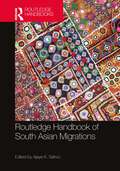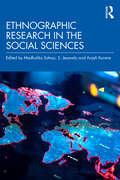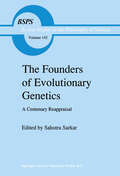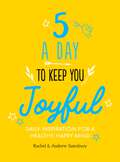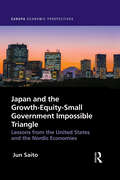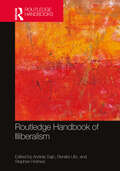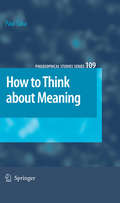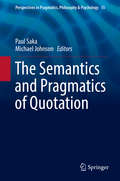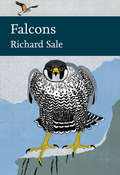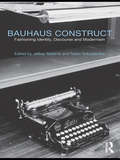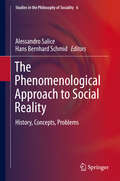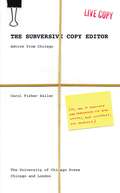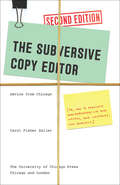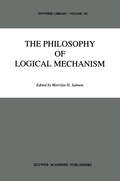- Table View
- List View
Routledge Handbook of South Asian Migrations
by Ajaya K. SahooRoutledge Handbook of South Asian Migrations presents cutting-edge research on South Asian migrants written from a diverse theoretical and methodological perspective by leading scholars from around the world. This book provides a comprehensive understanding of how South Asians negotiate and promote South Asian culture both within and outside the region while undergoing several challenges during the process of migration. The Handbook covers many dimensions of South Asian migrations written by leading scholars from across the world, including but not limited to sociology, history, anthropology, economics, political science, geography, education, psychology, literature, and cultural studies. Divided thematically into five broad sections the chapters critically analyse some of the pertinent issues of South Asian migrations: • Contextualizing South Asian Migrations • Migration, Language, and Identity • Politics of Migration and Development • Gender, Culture, and Migration • Migration, Diaspora, and Transnationalism Addressing these issues from a multidisciplinary, multigenerational, multiracial, and multi-ethnic perspective, the Routledge Handbook of South Asian Migrations fills a gap in the literature and is an invaluable resource for students and scholars throughout the social sciences and humanities.
Ethnographic Research in the Social Sciences
by Madhulika Sahoo S. Jeyavelu Anjali KuraneThis book is an essential guide to scientifically conducting contemporary ethnographic research at undergraduate, postgraduate, and doctoral levels in the social sciences, the humanities, and business studies. It addresses the methodological challenges of ethnographic research across the social sciences and highlights present time research areas, including digital ethnography, artificial intelligence, classroom pedagogy, hybrid organization, and many more. This volume is divided into three parts and can be a single source of reference that— • Guides students through essential theoretical and conceptual aspects of ethnography; • Demonstrates the usage of ethnography in allied disciplines—psychology, healthcare, international border studies, linguistic, artificial intelligence, and organizational behaviour; • Demonstrates the application of ethnographic research in the field; • Presents valuable lessons from fieldwork experiences by different scholars across a variety of communities; • Includes dos and don’ts for early career and first-time researchers. A step-by-step guide with student-friendly text, this book will be an essential supplementary reading across the social sciences and the humanities, especially for those conducting fieldwork in the Global South.
The Founders of Evolutionary Genetics: A Centenary Reappraisal (Boston Studies in the Philosophy and History of Science #142)
by SahotraSarkargenetics. " It is simply the appropriation of that term, very likely with insufficient knowledge and respect for its past usage. For that, the Editor alone is responsible and requests tolerance. He has, as far as he can tell, no intention or desire to use it for any historiographical purposes other than that just mentioned. Even more important, the decision to consider Muller together with Fisher, Haldane and Wright is also not original. Crow (1984) has already done so, arguing persua sively that Muller was "keenly interested in evolution and made sub stantial contributions to the development of the neo-Darwinian view. " Crow's reasons for considering these four figures together and the reasons discussed above are complementary. This book continues a historiographical choice he initiated; others will have to judge whether it is appropriate. The foregoing considerations were intended to show why Fisher, Haldane, Muller and Wright should be considered together in the history of theoretical evolutionary genetics. I By a welcome stroke of luck, from the point of view of the Editor, all four of these figures were born almost together, between 1889 and 1892, and almost exactly a century ago. It therefore seemed appropriate to use their birth cente naries to consider their work together. A conference was held at Boston University, on March 6, 1990, under the auspices of the Boston Center for the Philosophy and History of Science, to discuss their work. This book has emerged mainly from that conference.
Five A Day to Keep You Joyful: Daily Inspiration for a Healthy, Happy Mind
by Andrew Sainsbury Rachel SainsburyEveryone knows it’s good to eat five portions of fruit and veggies a to keep your body in tip-top condition, but what about a five-a-day for your mind? With wise words on the topics of mindfulness, friendship, appreciation, kindness and happiness, this is an inspirational little book that could have a BIG impact on your day.
Japan and the Growth-Equity-Small Government Impossible Triangle: Lessons from the United States and the Nordic Economies (Europa Economic Perspectives)
by Jun SaitoThis volume examines and analyzes the current situation of, and the future prospects for, the Japanese economy, particularly in the context of inequality. The country's economy is facing the ageing and the shrinking of its population, both of which will reduce the potential growth rate, which has already become very low. By introducing a new policy framework, namely the `Equity-Growth-Small Government Impossible Triangle', based on reviewing, comparing and contrasting the policies of the United States, the Nordic economies and Japan, the book proposes a policy direction that could be pursued by Japan. If Japan wants to sustain growth while preventing inequality to widen and preserve an egalitarian society, there is no other choice but to further promote globalization and innovation and, at the same time, surrender preserving a small government by reforming itself to become a dynamic and resilient welfare state. The volume will be an invaluable resource for students, professionals and researchers with an interest in economics, inequality, the Japanese economy and comparative economic policies.
Japan and the Growth-Equity-Small Government Impossible Triangle: Lessons from the United States and the Nordic Economies (Europa Economic Perspectives)
by Jun SaitoThis volume examines and analyzes the current situation of, and the future prospects for, the Japanese economy, particularly in the context of inequality. The country's economy is facing the ageing and the shrinking of its population, both of which will reduce the potential growth rate, which has already become very low. By introducing a new policy framework, namely the `Equity-Growth-Small Government Impossible Triangle', based on reviewing, comparing and contrasting the policies of the United States, the Nordic economies and Japan, the book proposes a policy direction that could be pursued by Japan. If Japan wants to sustain growth while preventing inequality to widen and preserve an egalitarian society, there is no other choice but to further promote globalization and innovation and, at the same time, surrender preserving a small government by reforming itself to become a dynamic and resilient welfare state. The volume will be an invaluable resource for students, professionals and researchers with an interest in economics, inequality, the Japanese economy and comparative economic policies.
Routledge Handbook of Illiberalism
by András SajóThe Routledge Handbook of IIliberalism is the first authoritative reference work dedicated to illiberalism as a complex social, political, cultural, legal, and mental phenomenon. Although illiberalism is most often discussed in political and constitutional terms, its study cannot be limited to such narrow frames. This Handbook comprises sixty individual chapters authored by an internationally recognized group of experts who present perspectives and viewpoints from a wide range of academic disciplines. Chapters are devoted to different facets of illiberalism, including the history of the idea and its competitors, its implications for the economy, society, government and the international order, and its contemporary iterations in representative countries and regions. The Routledge Handbook of IIliberalism will form an important component of any library's holding; it will be of benefit as an academic reference, as well as being an indispensable resource for practitioners, among them journalists, policy makers and analysts, who wish to gain an informed understanding of this complex phenomenon.
Routledge Handbook of Illiberalism
by András Sajó Renáta Uitz Stephen HolmesThe Routledge Handbook of IIliberalism is the first authoritative reference work dedicated to illiberalism as a complex social, political, cultural, legal, and mental phenomenon. Although illiberalism is most often discussed in political and constitutional terms, its study cannot be limited to such narrow frames. This Handbook comprises sixty individual chapters authored by an internationally recognized group of experts who present perspectives and viewpoints from a wide range of academic disciplines. Chapters are devoted to different facets of illiberalism, including the history of the idea and its competitors, its implications for the economy, society, government and the international order, and its contemporary iterations in representative countries and regions. The Routledge Handbook of IIliberalism will form an important component of any library's holding; it will be of benefit as an academic reference, as well as being an indispensable resource for practitioners, among them journalists, policy makers and analysts, who wish to gain an informed understanding of this complex phenomenon.
How to Think about Meaning (Philosophical Studies Series #109)
by Paul SakaAccording to truth-conditional semantics, to explain the meaning of a statement is to specify the conditions necessary and sufficient for its truth. This book develops a more radical mentalist semantics by shifting the object of semantic inquiry. Classical semantics analyzes an abstract sentence or utterance such as "Grass is green"; in attitudinal semantics the object of inquiry is a propositional attitude such as "Speaker so-and-so thinks grass is green".
The Semantics and Pragmatics of Quotation (Perspectives in Pragmatics, Philosophy & Psychology #15)
by Paul Saka Michael JohnsonThe chapters in this volume address a variety of issues surrounding quotation, such as whether it is a pragmatic or semantic phenomenon, what varieties of quotation exist, and what speech acts are involved in quoting. Quotation poses problems for many prevailing theories of language. One fundamental principle is that for a language to be learnable, speakers must be able to derive the truth-conditions of sentences from the meanings of their parts. Another popular view is that indexical expressions like "I" display a certain fixity -- that they always refer to the speaker using them. Both of these tenets appear to be violated by quotation. This volume is suitable for scholars in philosophy of language, semantics, and pragmatics, and for graduate students in philosophy and linguistics. The book will also be useful for researchers in other fields that study quotation, including psychology and computer science.
Falcons (Collins New Naturalist Library #132)
by Richard SaleFalcons have been a source of inspiration to writers, artists, historians and naturalists alike.
Bauhaus Construct: Fashioning Identity, Discourse and Modernism
by Jeffrey Saletnik Robin SchuldenfreiReconsidering the status and meaning of Bauhaus objects in relation to the multiple re-tellings of the school’s history, this volume positions art objects of the Bauhaus within the theoretical, artistic, historical, and cultural concerns in which they were produced and received. Contributions from leading scholars writing in the field today – including Frederic J. Schwartz, Magdalena Droste, and Alina Payne – offer an entirely new treatment of the Bauhaus. Issues such as art and design pedagogy, the practice of photography, copyright law, and critical theory are discussed. Through a strong thematic structure, new archival research and innovative methodologies, the questions and subsequent conclusions presented here re-examine the history of the Bauhaus and its continuing legacy. Essential reading for anyone studying the Bauhaus, modern art and design.
Bauhaus Construct: Fashioning Identity, Discourse and Modernism
by Jeffrey Saletnik Robin SchuldenfreiReconsidering the status and meaning of Bauhaus objects in relation to the multiple re-tellings of the school’s history, this volume positions art objects of the Bauhaus within the theoretical, artistic, historical, and cultural concerns in which they were produced and received. Contributions from leading scholars writing in the field today – including Frederic J. Schwartz, Magdalena Droste, and Alina Payne – offer an entirely new treatment of the Bauhaus. Issues such as art and design pedagogy, the practice of photography, copyright law, and critical theory are discussed. Through a strong thematic structure, new archival research and innovative methodologies, the questions and subsequent conclusions presented here re-examine the history of the Bauhaus and its continuing legacy. Essential reading for anyone studying the Bauhaus, modern art and design.
Aughey and Frye’s Comparative Veterinary Histology with Clinical Correlates
by Francisco Javier Salguero Bodes Francisco Jose Pallares MartinezOrganised by body system, the new edition of this highly illustrated textbook covers the normal histological appearance of tissues in a wide range of animals, both domestic and exotic species, with relevant clinical correlates emphasising the need to appreciate the normal in order to recognise the abnormal. In this update by two experienced veterinary pathologists and histology lecturers, new species, such as other companion mammals, aquatic species, and livestock, are introduced into each chapter along with a wealth of new high-quality images. A new chapter covers epitehlial tissue, and new techniques used in histology and histopathology are discussed throughout, including in situ hybridisation (ISH) and digital image analysis. Pathogenesis explanations are introduced in the current (and many new) cases of histopathology. The breadth of coverage - farm animals, dogs, cats, horses, birds, reptiles, amphibians, and fish - and the integration of normal and abnormal tissue provide a reference of lasting value to veterinary students as well as veterinary practitioners and pathologists requiring a quick refresher.
Aughey and Frye’s Comparative Veterinary Histology with Clinical Correlates
by Francisco Javier Salguero Bodes Francisco Jose Pallares MartinezOrganised by body system, the new edition of this highly illustrated textbook covers the normal histological appearance of tissues in a wide range of animals, both domestic and exotic species, with relevant clinical correlates emphasising the need to appreciate the normal in order to recognise the abnormal. In this update by two experienced veterinary pathologists and histology lecturers, new species, such as other companion mammals, aquatic species, and livestock, are introduced into each chapter along with a wealth of new high-quality images. A new chapter covers epitehlial tissue, and new techniques used in histology and histopathology are discussed throughout, including in situ hybridisation (ISH) and digital image analysis. Pathogenesis explanations are introduced in the current (and many new) cases of histopathology. The breadth of coverage - farm animals, dogs, cats, horses, birds, reptiles, amphibians, and fish - and the integration of normal and abnormal tissue provide a reference of lasting value to veterinary students as well as veterinary practitioners and pathologists requiring a quick refresher.
The Phenomenological Approach to Social Reality: History, Concepts, Problems (Studies in the Philosophy of Sociality #6)
by Alessandro Salice Hans Bernhard SchmidThis volume features fourteen essays that examine the works of key figures within the phenomenological movement in a clear and accessible way. It presents the fertile, groundbreaking, and unique aspects of phenomenological theorizing against the background of contemporary debate about social ontology and collective intentionality.The expert contributors explore the insights of such thinkers as Martin Heidegger, Edmund Husserl, Adolf Reinach, and Max Scheler. Readers will also learn about other sources that, although almost wholly neglected by historians of philosophy, testify to the vitality of the phenomenological tradition. In addition, the contributions highlight the systematic relevance of phenomenological research by pinpointing its position on social ontology and collective intentionality within the history of philosophy.By presenting phenomenological contributions in a scholarly yet accessible way, this volume introduces an interesting and important perspective into contemporary debate insofar as it bridges the gap between the analytical and the continental traditions in social philosophy. The volume provides readers with a deep understanding into such questions as: What does it mean to share experiences with others? What does it mean to share emotions with friends or to share intentions with partners in a joint endeavor? What are groups? What are institutional facts like money, universities, and cocktail parties? What are values and what role do values play in social reality?
The Subversive Copy Editor: Advice from Chicago (or, How to Negotiate Good Relationships with Your Writers, Your Colleagues, and Yourself) (Chicago Guides to Writing, Editing, and Publishing)
by Carol Fisher SallerEach year writers and editors submit over three thousand grammar and style questions to the Q&A page at The Chicago Manual of Style Online. Some are arcane, some simply hilarious—and one editor, Carol Fisher Saller, reads every single one of them. All too often she notes a classic author-editor standoff, wherein both parties refuse to compromise on the "rights" and "wrongs" of prose styling: "This author is giving me a fit." "I wish that I could just DEMAND the use of the serial comma at all times." "My author wants his preface to come at the end of the book. This just seems ridiculous to me. I mean, it’s not a post-face." In The Subversive Copy Editor, Saller casts aside this adversarial view and suggests new strategies for keeping the peace. Emphasizing habits of carefulness, transparency, and flexibility, she shows copy editors how to build an environment of trust and cooperation. One chapter takes on the difficult author; another speaks to writers themselves. Throughout, the focus is on serving the reader, even if it means breaking "rules" along the way. Saller’s own foibles and misadventures provide ample material: "I mess up all the time," she confesses. "It’s how I know things." Writers, Saller acknowledges, are only half the challenge, as copy editors can also make trouble for themselves. (Does any other book have an index entry that says "terrorists. See copy editors"?) The book includes helpful sections on e-mail etiquette, work-flow management, prioritizing, and organizing computer files. One chapter even addresses the special concerns of freelance editors. Saller’s emphasis on negotiation and flexibility will surprise many copy editors who have absorbed, along with the dos and don’ts of their stylebooks, an attitude that their way is the right way. In encouraging copy editors to banish their ignorance and disorganization, insecurities and compulsions, the Chicago Q&A presents itself as a kind of alter ego to the comparatively staid Manual of Style. In The Subversive Copy Editor, Saller continues her mission with audacity and good humor.
The Subversive Copy Editor, Second Edition: Advice from Chicago (or, How to Negotiate Good Relationships with Your Writers, Your Colleagues, and Yourself) (Chicago Guides to Writing, Editing, and Publishing)
by Carol Fisher SallerLongtime manuscript editor and Chicago Manual of Style guru Carol Fisher Saller has negotiated many a standoff between a writer and editor refusing to compromise on the “rights” and “wrongs” of prose styling. Saller realized that when these sides squared off, it was often the reader who lost. In her search for practical strategies for keeping the peace, The Subversive Copy Editor was born. Saller’s ideas struck a chord, and the little book with big advice quickly became a must-have reference for copy editors everywhere. In this second edition, Saller adds new chapters, on the dangers of allegiance to outdated grammar and style rules and on ways to stay current in language and technology. She expands her advice for writers on formatting manuscripts for publication, on self-editing, and on how not to be “difficult.” Saller’s own gaffes provide firsthand (and sometimes humorous) examples of exactly what not to do. The revised content reflects today’s publishing practices while retaining the self-deprecating tone and sharp humor that helped make the first edition so popular. Saller maintains that through carefulness, transparency, and flexibility, editors can build trust and cooperation with writers. The Subversive Copy Editor brings a refreshingly levelheaded approach to the classic battle between writers and editors. This sage advice will prove useful and entertaining to anyone charged with the sometimes perilous task of improving the writing of others.
The Subversive Copy Editor, Second Edition: Advice from Chicago (or, How to Negotiate Good Relationships with Your Writers, Your Colleagues, and Yourself) (Chicago Guides to Writing, Editing, and Publishing)
by Carol Fisher SallerLongtime manuscript editor and Chicago Manual of Style guru Carol Fisher Saller has negotiated many a standoff between a writer and editor refusing to compromise on the “rights” and “wrongs” of prose styling. Saller realized that when these sides squared off, it was often the reader who lost. In her search for practical strategies for keeping the peace, The Subversive Copy Editor was born. Saller’s ideas struck a chord, and the little book with big advice quickly became a must-have reference for copy editors everywhere. In this second edition, Saller adds new chapters, on the dangers of allegiance to outdated grammar and style rules and on ways to stay current in language and technology. She expands her advice for writers on formatting manuscripts for publication, on self-editing, and on how not to be “difficult.” Saller’s own gaffes provide firsthand (and sometimes humorous) examples of exactly what not to do. The revised content reflects today’s publishing practices while retaining the self-deprecating tone and sharp humor that helped make the first edition so popular. Saller maintains that through carefulness, transparency, and flexibility, editors can build trust and cooperation with writers. The Subversive Copy Editor brings a refreshingly levelheaded approach to the classic battle between writers and editors. This sage advice will prove useful and entertaining to anyone charged with the sometimes perilous task of improving the writing of others.
The Subversive Copy Editor, Second Edition: Advice from Chicago (or, How to Negotiate Good Relationships with Your Writers, Your Colleagues, and Yourself) (Chicago Guides to Writing, Editing, and Publishing)
by Carol Fisher SallerLongtime manuscript editor and Chicago Manual of Style guru Carol Fisher Saller has negotiated many a standoff between a writer and editor refusing to compromise on the “rights” and “wrongs” of prose styling. Saller realized that when these sides squared off, it was often the reader who lost. In her search for practical strategies for keeping the peace, The Subversive Copy Editor was born. Saller’s ideas struck a chord, and the little book with big advice quickly became a must-have reference for copy editors everywhere. In this second edition, Saller adds new chapters, on the dangers of allegiance to outdated grammar and style rules and on ways to stay current in language and technology. She expands her advice for writers on formatting manuscripts for publication, on self-editing, and on how not to be “difficult.” Saller’s own gaffes provide firsthand (and sometimes humorous) examples of exactly what not to do. The revised content reflects today’s publishing practices while retaining the self-deprecating tone and sharp humor that helped make the first edition so popular. Saller maintains that through carefulness, transparency, and flexibility, editors can build trust and cooperation with writers. The Subversive Copy Editor brings a refreshingly levelheaded approach to the classic battle between writers and editors. This sage advice will prove useful and entertaining to anyone charged with the sometimes perilous task of improving the writing of others.
The Subversive Copy Editor, Second Edition: Advice from Chicago (or, How to Negotiate Good Relationships with Your Writers, Your Colleagues, and Yourself) (Chicago Guides to Writing, Editing, and Publishing)
by Carol Fisher SallerLongtime manuscript editor and Chicago Manual of Style guru Carol Fisher Saller has negotiated many a standoff between a writer and editor refusing to compromise on the “rights” and “wrongs” of prose styling. Saller realized that when these sides squared off, it was often the reader who lost. In her search for practical strategies for keeping the peace, The Subversive Copy Editor was born. Saller’s ideas struck a chord, and the little book with big advice quickly became a must-have reference for copy editors everywhere. In this second edition, Saller adds new chapters, on the dangers of allegiance to outdated grammar and style rules and on ways to stay current in language and technology. She expands her advice for writers on formatting manuscripts for publication, on self-editing, and on how not to be “difficult.” Saller’s own gaffes provide firsthand (and sometimes humorous) examples of exactly what not to do. The revised content reflects today’s publishing practices while retaining the self-deprecating tone and sharp humor that helped make the first edition so popular. Saller maintains that through carefulness, transparency, and flexibility, editors can build trust and cooperation with writers. The Subversive Copy Editor brings a refreshingly levelheaded approach to the classic battle between writers and editors. This sage advice will prove useful and entertaining to anyone charged with the sometimes perilous task of improving the writing of others.
The Subversive Copy Editor, Second Edition: Advice from Chicago (or, How to Negotiate Good Relationships with Your Writers, Your Colleagues, and Yourself) (Chicago Guides to Writing, Editing, and Publishing)
by Carol Fisher SallerLongtime manuscript editor and Chicago Manual of Style guru Carol Fisher Saller has negotiated many a standoff between a writer and editor refusing to compromise on the “rights” and “wrongs” of prose styling. Saller realized that when these sides squared off, it was often the reader who lost. In her search for practical strategies for keeping the peace, The Subversive Copy Editor was born. Saller’s ideas struck a chord, and the little book with big advice quickly became a must-have reference for copy editors everywhere. In this second edition, Saller adds new chapters, on the dangers of allegiance to outdated grammar and style rules and on ways to stay current in language and technology. She expands her advice for writers on formatting manuscripts for publication, on self-editing, and on how not to be “difficult.” Saller’s own gaffes provide firsthand (and sometimes humorous) examples of exactly what not to do. The revised content reflects today’s publishing practices while retaining the self-deprecating tone and sharp humor that helped make the first edition so popular. Saller maintains that through carefulness, transparency, and flexibility, editors can build trust and cooperation with writers. The Subversive Copy Editor brings a refreshingly levelheaded approach to the classic battle between writers and editors. This sage advice will prove useful and entertaining to anyone charged with the sometimes perilous task of improving the writing of others.
The Subversive Copy Editor, Second Edition: Advice from Chicago (or, How to Negotiate Good Relationships with Your Writers, Your Colleagues, and Yourself) (Chicago Guides to Writing, Editing, and Publishing)
by Carol Fisher SallerLongtime manuscript editor and Chicago Manual of Style guru Carol Fisher Saller has negotiated many a standoff between a writer and editor refusing to compromise on the “rights” and “wrongs” of prose styling. Saller realized that when these sides squared off, it was often the reader who lost. In her search for practical strategies for keeping the peace, The Subversive Copy Editor was born. Saller’s ideas struck a chord, and the little book with big advice quickly became a must-have reference for copy editors everywhere. In this second edition, Saller adds new chapters, on the dangers of allegiance to outdated grammar and style rules and on ways to stay current in language and technology. She expands her advice for writers on formatting manuscripts for publication, on self-editing, and on how not to be “difficult.” Saller’s own gaffes provide firsthand (and sometimes humorous) examples of exactly what not to do. The revised content reflects today’s publishing practices while retaining the self-deprecating tone and sharp humor that helped make the first edition so popular. Saller maintains that through carefulness, transparency, and flexibility, editors can build trust and cooperation with writers. The Subversive Copy Editor brings a refreshingly levelheaded approach to the classic battle between writers and editors. This sage advice will prove useful and entertaining to anyone charged with the sometimes perilous task of improving the writing of others.
Vagueness as Arbitrariness: Outline of a Theory of Vagueness (Synthese Library #436)
by Sagid SallesThis book proposes a new solution to the problem of vagueness. There are several different ways of addressing this problem and no clear agreement on which one is correct. The author proposes that it should be understood as the problem of explaining vague predicates in a way that systematizes six intuitions about the phenomenon and satisfies three criteria of adequacy for an ideal theory of vagueness. The third criterion, which is called the “criterion of precisification”, is the most controversial one. It is based on the intuition that a predicate is vague only if it is imprecise. The author considers some different definitions of linguistic imprecision, proposing that a predicate is imprecise if and only if there is no sharp boundary between objects to which its application yields some particular truth-value and objects to which its application does not yield that truth-value. The volume critically reviews the current theories of vagueness and proposes a new one, the Theory of Vagueness as Arbitrariness, which defines a vague predicate as an arbitrary predicate that must be precisified in order to contribute to a sentence that has truth-conditions. The main advantages of this theory over the current alternatives are that it satisfies all three criteria and systematizes the relevant intuitions.
The Philosophy of Logical Mechanism: Essays in Honor of Arthur W. Burks, With his responses (Synthese Library #206)
by Merrilee H. SalmonThis work is divided into two parts. Part I contains sixteen critical es says by prominent philosophers and computer scientists. Their papers offer insightful, well-argued contemporary views of a broad range of topics that lie at the heart of philosophy in the second half of the twen tieth century: semantics and ontology, induction, the nature of prob ability, the foundations of science, scientific objectivity, the theory of naming, the logic of conditionals, simulation modeling, the relatiOn be tween minds and machines, and the nature of rules that guide be havior. In this volume honoring Arthur W. Burks, the philosophical breadth of his work is thus manifested in the diverse aspects of that work chosen for discussion and development by the contributors to his Festschrift. Part II consists of a book-length essay by Burks in which he lays out his philosophy of logical mechanism while responding to the papers in Part I. In doing so, he provides a unified and coherent context for the range of problems raised in Part I, and he highlights interesting relationships among the topics that might otherwise have gone un noticed. Part II is followed by a bibliography of Burks's published works.
